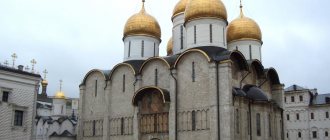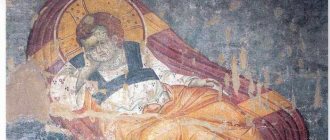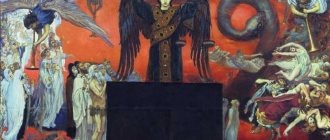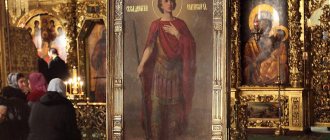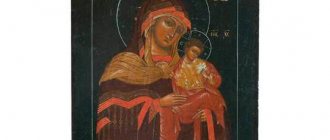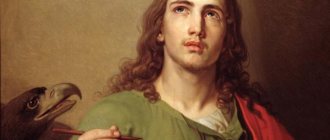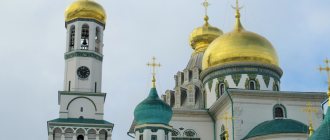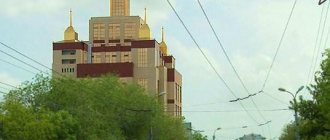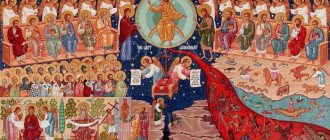Prayer 1
O Most Holy Lady Lady Theotokos! Thou art the highest angel and archangel of all, and the most honest of all creatures, the helper of the offended, the hopeless hope, the poor intercessor, the sad consolation, the hungry nurse, the naked garment, the healing of the sick, the salvation of sinners, the help and intercession of all Christians! O All-Merciful Lady, Virgin Mother of God Lady, by Your mercy save and have mercy on our God-protected country, its authorities and army, and all Orthodox Christians, protect us with Your honorable robe: and pray, Lady, from You, without seed, Christ our God incarnate, may he gird us with strength From above against our invisible and visible enemies. O All-Merciful Lady, Sovereign Mother of God, raise us from the depths of sin and deliver us from famine, destruction, from cowardice and flood, from fire and sword, from the presence of foreigners and internecine warfare, and from vain death, and from attacks of the enemy, and from pernicious wind, and from deadly plagues, and from all evil. Grant, O Lady, peace and health to Thy servant, all Orthodox Christians, and enlighten their minds and the eyes of their hearts to salvation: and make us, Thy sinful servants, worthy of the kingdom of Thy Son, Christ our God: for His power is blessed and glorified, with His Beginningless Father, and with the Most Holy, and Good, and His Life-giving Spirit, now and ever, and unto ages of ages, Amen.
Fragrant Color
The miraculous Izmail icon of the Most Holy Theotokos was brought to Samara.
...The bells began to ring joyfully, and the parishioners of the Samara Church of the Exaltation of the Cross, headed by the rector, Priest Valery Zaraisky, excitedly met the miraculous icon of the Most Holy Theotokos “Fragrant Flower” (Ishmael). The main shrine of the St. Constantine-Eleninsky Izmail Monastery of the Odessa Diocese has arrived in Samara. From September 27 to November 7, this icon will be located alternately in the churches of Samara. For two days in October, she also stayed at the Church of the Exaltation of the Cross, where our editorial office is located. After the first prayer service, at which Blagovest employees also prayed, I approached Natalya Kalina, who was accompanying the icon on the trip, and asked for an interview. And Natalya Kalina said:
— This is a revered image of the St. Constantine-Eleninsky Izmail Monastery. The monastery was established in 1936 on the basis of the Church of Saints Equal-to-the-Apostles Constantine and Helen, then it belonged to the Romanian Metropolis.
— That's it! But I, having read it on the Internet, was surprised: how is it possible, in the midst of persecution of the Church in the USSR, and suddenly a new monastery was founded?!
— After the revolution, this part of Ukraine went to Bessarabia and until 1940 was part of Romania. So, by the Providence of God, the monastery was active for a long time and closed already in 1962, during Khrushchev’s persecutions. And it was opened again with the blessing of Metropolitan Agathangel of Odessa and Izmail in 2001. And three years later, the “Fragrant Flower” icon returned to the monastery - and in the same 2004, the first myrrh streaming from the icon was noted. Probably, by this miracle, the Most Holy Theotokos showed that the icon not only returned to its native monastery, but that it was in its place where it was originally intended to be.
Unfortunately, there is little information about previous miracles from the icon, because documentary evidence remained in Romania. Only popular veneration and oral tradition testify that healings have occurred through prayers before the icon. It is known that the icon was painted for a pious married couple, George and Mary, and the icon depicts the Great Martyr George the Victorious and Equal-to-the-Apostles Mary Magdalene, the Heavenly patrons of this family, standing before the Most Holy Theotokos and the Infant Christ. When miracles began from the icon, George and Maria gave the icon to the temple. Most of all there were healings from diseases, other miracles were performed - and to this day people receive grace-filled help. Thus, a woman with leukemia from Krasnopolye - a suburb of Dnepropetrovsk (now Dnepr) - when the icon was brought to Dnepropetrovsk, she went to venerate this shrine. And through prayers before the Fragrant Flower icon, she was completely healed.
We travel with the shrine, and believers flock to the icon. And although the icon and I are in one place for two or three days, even during this short time it happened several times that people came and said that they had received help, the Queen of Heaven helped with their everyday needs and illnesses. And I myself can say that almost everything I asked for in prayers from this icon was soon miraculously resolved.
And on one trip there was an amazing incident that concerned not just one person personally, but many. The icon and I arrived in a Siberian village, and the residents of the neighboring village, where there was no church, really asked to bring this shrine to them. And so we arrived there. Residents walked with the icon in a religious procession through the village, and the icon remained in the village chapel in the evening, at night and in the morning. The priest from the village where we came from with the icon served a prayer service. What is surprising is how great faith is even where there is not even a temple! — people walked until ten o’clock in the evening, cried and prayed. Moreover, there were many unbaptized people, and they still went to the shrine, wanting to order requests for themselves and the same unbaptized relatives. But this is impossible... And I suggested that they make lists of people who want to be baptized and approach the priest so that he can come and baptize on the appointed day. Then it will be possible to pray for them in church. Father happily agreed: “Okay, of course, I’ll come and baptize you!”
So here it is. The village really wanted to have a temple. From the small funds collected for the construction of the temple, they built a chapel and prayed for God’s help in the construction of the temple.
They were given some place - there was literally a dump there. They cleared everything out and poured the foundation. And - everything stalled... And when the icon stayed in the chapel for one night, it was the next day, and not at any other time, that KAMAZ went for the first batch of bricks for the temple!
— So this icon is also a temple builder?
“I say: in all our worries, the icon shows the help of the Most Holy Theotokos. It happens that you don’t even dare to ask, you just think: oh, I would like this... - and already everything is decided. But most of all - healing from illnesses, mental and physical. And they also pray for family well-being, for preservation of cleanliness, for the prevention of family disorder and divorce. In difficult life circumstances, in sorrows.
— Do you have a family yourself?
- Well, how can I say... The son is an adult. And the family fell apart. Not everything in our lives happens the way we want. But for some reason it is necessary. Most likely, for spiritual life.
— How long have you been traveling with the icon?
— In general, we come back periodically. We need to visit home, and then we go to Russia again. While there is an opportunity... After Samara, the Otradnensky diocese of the Samara Metropolis awaits us. And from there - again to his monastery.
— Where did they come to Samara from?
- Straight from Ishmael. The Intercession Cathedral was the very first in Samara to greet the icon. Then the churches of Peter and Paul, Cyril and Methodius, the new St. Sophia Cathedral, both Samara monasteries. We will visit a total of sixteen churches in Samara.
I complained that there were few people meeting the icon that day, and Natalya smiled:
- Nothing! Whoever needs it will come. And whoever comes will receive help.
Father Valery Zaraisky, having invited both of us for a cup of tea and pies, actively participated in our conversation.
— How do you escape today in Ukraine? - asked the priest. — In such disorder, when self-appointed “bishops” ordain someone, someone goes to a schismatic “church”...
N.K.: Believers understand: this is a split, this is deception. But the overwhelming majority still remained faithful to the canonical Church. And of course, believers immediately, with the blessing of their Lords, went out to numerous religious processions. For Equal-to-the-Apostles Vladimir, 300 thousand people gathered from all over Ukraine. Just a human river flowed through Kyiv!
O.L.: And this is not the first year that such large religious processions have been held in Ukraine...
|
N.K.: Not the first. But after the infamous tomos, even more people came out to our religious processions. Also, the Pochaev Religious Procession of many thousands comes out every year from different parts of Ukraine. And even from Poland Orthodox Christians come to Pochaev. So watch the video: people are walking with these babies! Several days in the open air, in the heat! And this is the kind of power, what kind of faith that moves people.
And our Lords, addressing the people, say that persecution of the Church is the most favorable time for the Church. Before our eyes, the Church is being cleansed of those who are ready to betray. For some, career was more important than conscience; for others, something else was more important. Well, true believers do not betray their faith. Faith became even stronger.
Father Valery Zaraisky: Aren’t they afraid to go to their canonical churches?
N.K.: After the events of 2014, there was some kind of not so much fear, but rather apprehension, and the churches were somewhat empty. I worked at the Kiev Pechersk Lavra. Previously, pilgrims from Russia went there, group after group, thousands of people every day. And suddenly this flow stopped. Most of all, perhaps, because of the information in the media - both in Ukraine and in Russia, they constantly fanned fears. Well, gradually, the parishioners began to walk again and saw that no one was stopping them from praying. Pilgrims also appeared. Not as much as before, but they are coming.
And the seizures of churches took place in villages, mostly closer to Western Ukraine. It happened that doors were broken down and priests were beaten. For example, the chairman of the village council came and with him the villagers, who also succumbed to the influence: they say, everything should be Ukrainian...
O.L.: Without “Muscovites”...
N.K.: Well, yes. But ordinary farmers will not beat each other or attack the priest. It was the visiting radicals who acted.
In Ukraine, a lot of people have always gone and still go to churches. Moreover, at Vespers, the church is full. It’s not like just standing around at mass. And there are many communicants at the Liturgy.
Father Valery: Has it ever happened that groups of pilgrims were not allowed into Ukraine?
N.K.: I haven’t heard that. Pilgrims pray on the way. They are traveling on a bus, and the priest is with them. And all obstacles are wasted in front of them. But for ordinary citizens of Russia there is an entry restriction.
It is alarming that the Greek Church supported the schismatics. And this is already introducing division into Orthodoxy throughout the world!
At those very moments when we, having tea, shared these concerns, an extraordinary meeting of our Holy Synod was taking place in Moscow, at which the Russian Orthodox Church, through the mouth of the Holy Synod, said its weighty word about this!..
O.L.: Didn’t the tragic events of May 2, 2014 in Odessa frighten believers?
N.K.: Odessa residents are very strong in faith, you cannot intimidate them. Every night believers go around Odessa with processions of the Cross. The tomos had just been introduced, and already on the Annunciation on April 7, religious processions took place in such large cities as Odessa and Dnepropetrovsk. Processions of thousands with banners, icons, and prayerful singing of believers passed through the city, and it became clear to everyone that the people were with the Ukrainian Orthodox Church.
Father Valery: In 2014, our fraternal peoples became even more divided. Is it still possible to stitch this crack? She's getting more and more separated...
N.K.: But sooner or later the truth will prevail. The time will come when people will understand who is their friend and who is their enemy. In Ukraine, many people rely on European integration and think that America and European countries will support us...
O.L.: ...pies!
N.K.: Yes - with pies, like on the Maidan. And that the West will do everything for us. But in reality this never happened. And Russia is our only friend, and we are even a single people, and we must be together.
Father Valery: And we also had such euphoria in Russia in the late 80s and 90s. The Americans will come and everything will immediately become better than ever. Hollywood films, chewing gum, overseas curiosities... But it turned out that they didn’t need us at all, and only added more problems. People on the outskirts of the Soviet Union found themselves in such trouble that they abandoned everything they had acquired and left for Russia. It was a big tragedy. Now, it seems, Ukraine is going through something that has already happened in Russia.
N.K.: Well, we, believers, believe in what St. Lawrence of Chernigov and other elders said - that the time will come, and Russia and Ukraine will be united again. It cannot be otherwise.
Father Valery: Is it possible to buy books in Russian in Ukraine?
N.K.: Maybe there are no such books in state stores, but you can buy them freely at book markets.
Father Valery: And my favorite writer Gogol - how are they treating him now? They don’t consider him an “agent of Moscow” because he called Ukraine Russia?
N.K.: Of course: he is now declared a Ukrainian writer... And all the saints of Kievan Rus also became “Ukrainians”! Saints Vladimir and Olga... This is politics. Well, Russian literature in Ukraine has long been considered foreign. I don’t know if they teach it in schools now or not. But when my son was studying, she walked like a foreigner. And, for example, Yesenin’s poem is printed on a page in a column, and next to it is a translation in Ukrainian. This is impossible to translate, such a distortion!
O.L.: When the Gifts of the Magi were brought to Kiev from Athos, there was great hope that this shrine would miraculously pacify and stop the fermentation... But this did not happen.
N.K.: But because all this had to happen. Because the people in Ukraine have begun to strive very much for the West, and what good can come from this! And thank God that His Beatitude Metropolitan Onuphry did not make any compromises. With such pillars, the Ukrainian Orthodox Church will withstand all the current storms and will only grow stronger.
Recorded by Olga Larkina.
Photo by A. Zhogolev and the author.
Prayer 2
Oh, Most Holy Virgin - Mother of the Lord, Queen of heaven and earth, listen to the much-painful sighing of our souls, look down from Thy holy height upon us with faith and love who worship Thy most pure image, for we are immersed in sins and overwhelmed by sorrows, looking at Thy image as if alive To You who is with us, we offer our humble prayers. The imams have no other help, no other intercession, no consolation except You, O Mother of all who mourn and are burdened. Help us, the weak, assuage our sorrow, guide us who err on the right path, heal and save the hopeless, grant us the rest of our lives to spend in peace and silence. Grant a Christian death, and at the Last Judgment of Your Son, the merciful Intercessor will appear to us, may we always sing, magnify and glorify You, as the good intercessor of the Christian race with all those who have pleased God. Amen.
Website akafistnik.ru
Prototype and feature of the icon
The prototype for the “Fragrant Flower” icon was the “Unfading Flower” icon of the Mother of God. Initially, the difference between them was that the Mother of God was holding a branch with flowers in different hands. In modern icon painting this has ceased to play any role. And therefore, images that were previously perceived as different are today treated as one and the same.
The “Fragrant Flower” icon, like its prototype, belongs to the “Hodegetria” iconographic type. This is a clear canon of writing the Virgin Mary, different from all other types. It has its own characteristics and rules for depicting the image. For example, this canon is fundamentally different from the so-called Rublev style of writing saints.
Christians believe that the Fragrant Flower icon of the Mother of God helps believers in dangerous and difficult life situations. That is why it is especially revered, along with the image of Christ the Savior and the Holy Trinity.
Story
The appearance of this holy image dates back to approximately the 17th century. To date, the place of appearance is controversial, as there are two versions.
According to one of them, it is believed that this image first appeared on the Greek island of Athos, which, as you know, is of very great importance to Christians. The version of the appearance of the Fragrant Flower icon of the Mother of God here is supported by the fact that this place is considered the earthly Lot of the Mother of God.
Another version says that this icon appeared in Constantinople, called Constantinople in Slavic culture.
In Christian literature, mention of the icon appears around the same time. For the first time they write about it in Byzantine akathists. In them, the images of the Mother of God and Jesus are identified with fragrant flowers that do not fade.
The artistic elements that persist today were influenced by the traditions of icon painting in Western culture.
Artistic image
The Fragrant Flower icon, surprisingly, is not as often found in Orthodox churches as, for example, Kazan or Vladimir. However, it has special meaning for believers. It is believed that this image helps women and is a talisman for pregnant women.
From an artistic point of view, this is certainly one of the masterpieces of icon painting, which gave rise to a number of directions. It can definitely be said that “Fragrant Color” refers to unusual iconographic images - both visual and plot. Interpretations of the image are somewhat different in different Christian denominations. But they all agree that the image of the Mother of God carries purity, purity of thoughts and spiritual light.
Description
“Fragrant Flower” is an icon with the Mother of God, which has several options. This is very typical of the images that appeared in the late era of iconography. What unites all the icons is that they invariably contain a branch with flowers. Moreover, Jesus can be in both the left and right hand of the Virgin Mary. Just like a flower branch.
The background and edges of the icon are painted with various patterns and elements. Most often these are floral decorations, but there are also so-called geometric backgrounds. Sometimes you can see inscriptions on icons - both extensive and consisting only of the name of the icon itself. They are made in Old Church Slavonic or Latin. For example, “Our Lady and Jesus Christ.”
Another feature: on the Fragrant Flower icons, the Virgin Mary and Christ are depicted in royal robes, and their heads are crowned with halos. Usually the Mother of God was painted from the waist up, but there are images where she sits on a throne with Jesus on one hand and a sprig of flowers in the other, with her head uncovered. This speaks of different traditions of icon painting, each of which has its own canons and manner of painting holy faces.
First image
The earliest depiction of the “Fragrant Flower” image is given by historian D. Dallas. He refers to an engraving he found in the New Treasury Bible. The tome was published by Venetian printers in 1612. Among the Latin text there is an image of the Mother of God with little Jesus.
The Virgin Mary in this engraving stands on a rotated crescent. She holds Jesus in her arms, and roses grow from Christ's halo. This image is considered one of the first to be documented.
This engraving and copies from it are called “Madonna Rosencrantz”. They are very common in the Western Catholic tradition. Early icons are quite close to the original. Later ones have many differences both in the depiction of additional elements and in the very style of writing images.
